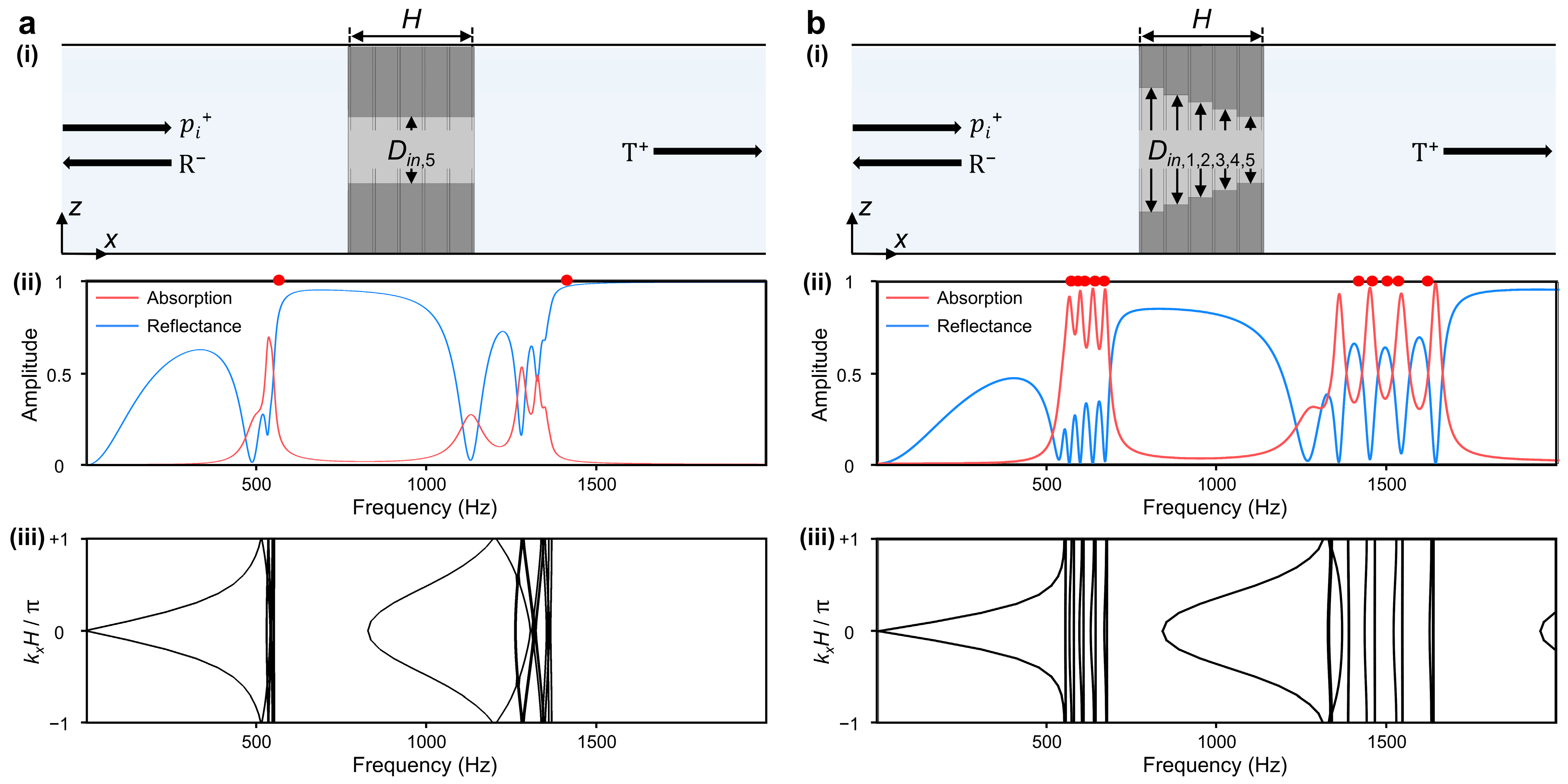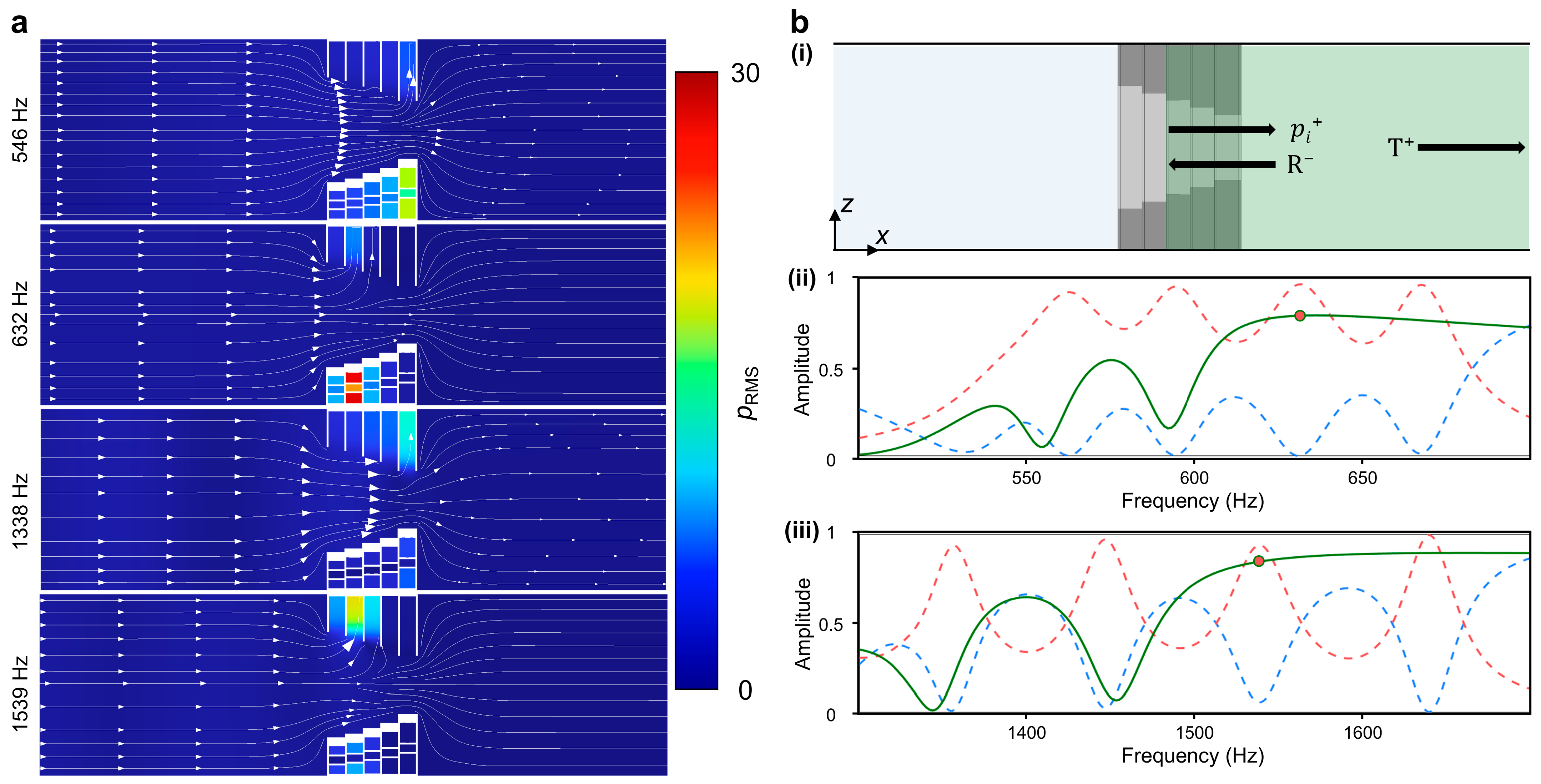Studies on Dual Helmholtz Resonators and Asymmetric Waveguides for Ventilated Soundproofing
Abstract
:1. Introduction
2. Design and Simulation for Acoustic Metastructure
3. Results and Discussion
3.1. Dual Helmholtz Resonators

3.2. Resonators in Asymmetric Waveguides
3.3. Performance and Functionality
4. Conclusions
Supplementary Materials
Author Contributions
Funding
Institutional Review Board Statement
Informed Consent Statement
Data Availability Statement
Conflicts of Interest
References
- Tao, Y.; Ren, M.; Zhang, H.; Peijs, T. Recent Progress in Acoustic Materials and Noise Control Strategies—A Review. Appl. Mater. Today 2021, 24, 101141. [Google Scholar] [CrossRef]
- Mir, F.; Mandal, D.; Banerjee, S. Metamaterials for Acoustic Noise Filtering and Energy Harvesting. Sensors 2023, 23, 4227. [Google Scholar] [CrossRef] [PubMed]
- Arenas, J.P.; Crocker, M.J. Recent Trends in Porous Sound-Absorbing Materials. Sound Vib. 2010, 44, 12–17. [Google Scholar]
- Cox, T.J.; D’Antonio, P. Acoustic Absorbers and Diffusers: Theory, Design and Application, 2nd ed.; Taylor & Francis: London, UK; New York, NY, USA, 2009; ISBN 978-0-415-47174-9. [Google Scholar]
- Kumar, S.; Lee, H. The Present and Future Role of Acoustic Metamaterials for Architectural and Urban Noise Mitigations. Acoustics 2019, 1, 590–607. [Google Scholar] [CrossRef]
- Ma, G.; Sheng, P. Acoustic Metamaterials: From Local Resonances to Broad Horizons. Sci. Adv. 2016, 2, e1501595. [Google Scholar] [CrossRef] [PubMed]
- Cummer, S.A.; Christensen, J.; Alù, A. Controlling Sound with Acoustic Metamaterials. Nat. Rev. Mater. 2016, 1, 16001. [Google Scholar] [CrossRef]
- Liu, Z.; Zhang, X.; Mao, Y.; Zhu, Y.Y.; Yang, Z.; Chan, C.T.; Sheng, P. Locally Resonant Sonic Materials. Sci. New Ser. 2000, 289, 1734–1736. [Google Scholar] [CrossRef]
- Fang, N.; Xi, D.; Xu, J.; Ambati, M.; Srituravanich, W.; Sun, C.; Zhang, X. Ultrasonic Metamaterials with Negative Modulus. Nat. Mater. 2006, 5, 452–456. [Google Scholar] [CrossRef]
- Fleury, R.; Alù, A. Extraordinary Sound Transmission through Density-Near-Zero Ultranarrow Channels. Phys. Rev. Lett. 2013, 111, 055501. [Google Scholar] [CrossRef]
- Cselyuszka, N.; Sečujski, M.; Crnojević Bengin, V. Compressibility-near-Zero Acoustic Metamaterial. Phys. Lett. A 2014, 378, 1153–1156. [Google Scholar] [CrossRef]
- Lee, S.H.; Park, C.M.; Seo, Y.M.; Wang, Z.G.; Kim, C.K. Composite Acoustic Medium with Simultaneously Negative Density and Modulus. Phys. Rev. Lett. 2010, 104, 054301. [Google Scholar] [CrossRef] [PubMed]
- Zhang, S.; Yin, L.; Fang, N. Focusing Ultrasound with an Acoustic Metamaterial Network. Phys. Rev. Lett. 2009, 102, 194301. [Google Scholar] [CrossRef] [PubMed]
- Li, Y.; Yu, G.; Liang, B.; Zou, X.; Li, G.; Cheng, S.; Cheng, J. Three-Dimensional Ultrathin Planar Lenses by Acoustic Metamaterials. Sci. Rep. 2014, 4, 6830. [Google Scholar] [CrossRef] [PubMed]
- Ma, F.; Huang, Z.; Liu, C.; Wu, J.H. Acoustic Focusing and Imaging via Phononic Crystal and Acoustic Metamaterials. J. Appl. Phys. 2022, 131, 011103. [Google Scholar] [CrossRef]
- Chen, H.; Chan, C.T. Acoustic Cloaking and Transformation Acoustics. J. Phys. D Appl. Phys. 2010, 43, 113001. [Google Scholar] [CrossRef]
- Zhu, X.; Liang, B.; Kan, W.; Zou, X.; Cheng, J. Acoustic Cloaking by a Superlens with Single-Negative Materials. Phys. Rev. Lett. 2011, 106, 014301. [Google Scholar] [CrossRef] [PubMed]
- Zigoneanu, L.; Popa, B.-I.; Cummer, S.A. Three-Dimensional Broadband Omnidirectional Acoustic Ground Cloak. Nat. Mater. 2014, 13, 352–355. [Google Scholar] [CrossRef]
- Zhang, J.; Rui, W.; Ma, C.; Cheng, Y.; Liu, X.; Christensen, J. Remote Whispering Metamaterial for Non-Radiative Transceiving of Ultra-Weak Sound. Nat. Commun. 2021, 12, 3670. [Google Scholar] [CrossRef]
- Wu, K.; Liu, J.-J.; Ding, Y.; Wang, W.; Liang, B.; Cheng, J.-C. Metamaterial-Based Real-Time Communication with High Information Density by Multipath Twisting of Acoustic Wave. Nat. Commun. 2022, 13, 5171. [Google Scholar] [CrossRef]
- Zhu, Y.-F.; Zou, X.-Y.; Liang, B.; Cheng, J.-C. Acoustic One-Way Open Tunnel by Using Metasurface. Appl. Phys. Lett. 2015, 107, 113501. [Google Scholar] [CrossRef]
- Cai, X.; Guo, Q.; Hu, G.; Yang, J. Ultrathin Low-Frequency Sound Absorbing Panels Based on Coplanar Spiral Tubes or Coplanar Helmholtz Resonators. Appl. Phys. Lett. 2014, 105, 121901. [Google Scholar] [CrossRef]
- Tang, Y.; Ren, S.; Meng, H.; Xin, F.; Huang, L.; Chen, T.; Zhang, C.; Lu, T.J. Hybrid Acoustic Metamaterial as Super Absorber for Broadband Low-Frequency Sound. Sci. Rep. 2017, 7, 43340. [Google Scholar] [CrossRef] [PubMed]
- Wang, X.; Luo, X.; Yang, B.; Huang, Z. Ultrathin and Durable Open Metamaterials for Simultaneous Ventilation and Sound Reduction. Appl. Phys. Lett. 2019, 115, 171902. [Google Scholar] [CrossRef]
- Xiang, X.; Wu, X.; Li, X.; Wu, P.; He, H.; Mu, Q.; Wang, S.; Huang, Y.; Wen, W. Ultra-Open Ventilated Metamaterial Absorbers for Sound-Silencing Applications in Environment with Free Air Flows. Extrem. Mech. Lett. 2020, 39, 100786. [Google Scholar] [CrossRef]
- Nguyen, H.; Wu, Q.; Xu, X.; Chen, H.; Tracy, S.; Huang, G. Broadband Acoustic Silencer with Ventilation Based on Slit-Type Helmholtz Resonators. Appl. Phys. Lett. 2020, 117, 134103. [Google Scholar] [CrossRef]
- Liu, C.; Wang, H.; Liang, B.; Cheng, J.; Lai, Y. Low-Frequency and Broadband Muffler via Cascaded Labyrinthine Metasurfaces. Appl. Phys. Lett. 2022, 120, 231702. [Google Scholar] [CrossRef]
- Ghaffarivardavagh, R.; Nikolajczyk, J.; Anderson, S.; Zhang, X. Ultra-Open Acoustic Metamaterial Silencer Based on Fano-like Interference. Phys. Rev. B 2019, 99, 024302. [Google Scholar] [CrossRef]
- Sun, M.; Fang, X.; Mao, D.; Wang, X.; Li, Y. Broadband Acoustic Ventilation Barriers. Phys. Rev. Appl. 2020, 13, 044028. [Google Scholar] [CrossRef]
- Chen, A.; Zhao, X.; Yang, Z.; Anderson, S.; Zhang, X. Broadband Labyrinthine Acoustic Insulator. Phys. Rev. Appl. 2022, 18, 064057. [Google Scholar] [CrossRef]
- Tang, Y.; Liang, B.; Lin, S. Broadband Ventilated Meta-Barrier Based on the Synergy of Mode Superposition and Consecutive Fano Resonances. J. Acoust. Soc. Am. 2022, 152, 2412–2418. [Google Scholar] [CrossRef]
- Zhu, Y.; Dong, R.; Mao, D.; Wang, X.; Li, Y. Nonlocal Ventilating Metasurfaces. Phys. Rev. Appl. 2023, 19, 014067. [Google Scholar] [CrossRef]
- Yang, J.; Lee, J.S.; Lee, H.R.; Kang, Y.J.; Kim, Y.Y. Slow-Wave Metamaterial Open Panels for Efficient Reduction of Low-Frequency Sound Transmission. Appl. Phys. Lett. 2018, 112, 091901. [Google Scholar] [CrossRef]
- Xiao, Z.; Gao, P.; Wang, D.; He, X.; Wu, L. Ventilated Metamaterials for Broadband Sound Insulation and Tunable Transmission at Low Frequency. Extrem. Mech. Lett. 2021, 46, 101348. [Google Scholar] [CrossRef]
- Kumar, S.; Lee, H.P. Labyrinthine Acoustic Metastructures Enabling Broadband Sound Absorption and Ventilation. Appl. Phys. Lett. 2020, 116, 134103. [Google Scholar] [CrossRef]
- Kumar, S.; Xiang, T.B.; Lee, H.P. Ventilated Acoustic Metamaterial Window Panels for Simultaneous Noise Shielding and Air Circulation. Appl. Acoust. 2020, 159, 107088. [Google Scholar] [CrossRef]
- Gao, Y.-X.; Cheng, Y.; Liang, B.; Li, Y.; Yang, J.; Cheng, J.-C. Acoustic Skin Meta-Muffler. Sci. China Phys. Mech. Astron. 2021, 64, 294311. [Google Scholar] [CrossRef]
- Dong, R.; Mao, D.; Wang, X.; Li, Y. Ultrabroadband Acoustic Ventilation Barriers via Hybrid-Functional Metasurfaces. Phys. Rev. Appl. 2021, 15, 024044. [Google Scholar] [CrossRef]
- Xu, M.B.; Selamet, A.; Kim, H. Dual Helmholtz Resonator. Appl. Acoust. 2010, 71, 822–829. [Google Scholar] [CrossRef]
- Jiménez, N. Acoustic Waves in Periodic Structures, Metamaterials, and Porous Media: From Fundamentals to Industrial Applications, 4th ed.; Springer: Cham, Switzerland, 2022; ISBN 978-3-030-84300-7. [Google Scholar]
- Kinsler, L.E.; Frey, A.R. Fundamentals of Acoustics, 4th ed.; John Wiley and Sons: New York, NY, USA, 2000; ISBN 978-0-471-84789-2. [Google Scholar]
- Sagartzazu, X.; Hervella-Nieto, L.; Pagalday, J.M. Review in Sound Absorbing Materials. Arch. Computat. Methods Eng. 2008, 15, 311–342. [Google Scholar] [CrossRef]
- Merkel, A.; Theocharis, G.; Richoux, O.; Romero-García, V.; Pagneux, V. Control of Acoustic Absorption in One-Dimensional Scattering by Resonant Scatterers. Appl. Phys. Lett. 2015, 107, 244102. [Google Scholar] [CrossRef]
- Jiménez, N.; Romero-García, V.; Pagneux, V.; Groby, J.-P. Rainbow-Trapping Absorbers: Broadband, Perfect and Asymmetric Sound Absorption by Subwavelength Panels for Transmission Problems. Sci. Rep. 2017, 7, 13595. [Google Scholar] [CrossRef]






| Layer Num | 1 | 2 | 3 | 4 | 5 |
|---|---|---|---|---|---|
| Din,i (=2 × rin,i) | 58 | 54 | 48 | 42 | 32 |
| f1 | 665 | 638 | 608 | 588 | 568 |
| f2 | 1618 | 1562 | 1499 | 1455 | 1415 |
| Wn2,ij | i = 1 | 2 | 3 | 4 | 5 |
|---|---|---|---|---|---|
| j = 1 | 4 | 4 | 4 | 4 | 4 |
| 2 | 4.3 | 4.7 | 4.6 | 4.6 | 4 |
| 3 | 4.7 | 5.5 | 5.2 | 5.2 | 4 |
Disclaimer/Publisher’s Note: The statements, opinions and data contained in all publications are solely those of the individual author(s) and contributor(s) and not of MDPI and/or the editor(s). MDPI and/or the editor(s) disclaim responsibility for any injury to people or property resulting from any ideas, methods, instructions or products referred to in the content. |
© 2024 by the authors. Licensee MDPI, Basel, Switzerland. This article is an open access article distributed under the terms and conditions of the Creative Commons Attribution (CC BY) license (https://creativecommons.org/licenses/by/4.0/).
Share and Cite
Han, I.; Lee, I.; Yoon, G. Studies on Dual Helmholtz Resonators and Asymmetric Waveguides for Ventilated Soundproofing. Sensors 2024, 24, 1432. https://doi.org/10.3390/s24051432
Han I, Lee I, Yoon G. Studies on Dual Helmholtz Resonators and Asymmetric Waveguides for Ventilated Soundproofing. Sensors. 2024; 24(5):1432. https://doi.org/10.3390/s24051432
Chicago/Turabian StyleHan, Inkyuk, Inho Lee, and Gwanho Yoon. 2024. "Studies on Dual Helmholtz Resonators and Asymmetric Waveguides for Ventilated Soundproofing" Sensors 24, no. 5: 1432. https://doi.org/10.3390/s24051432






